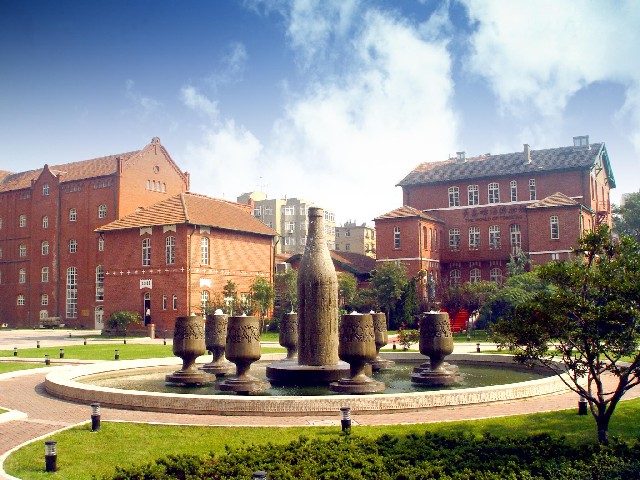 |
|
[Google.com] |
I had wanted to visit Qingdao for nearly 30 years. Why? Because of the beer, of course!
In 1979, when I first lived in Beijing, Tsingdao Beer was the beer in China (Yanjing did not come around until 1980). There were other regional beers, but few of them were very good and I looked for Tsingdao wherever I could find it.
I finally made it to Qingdao last month and I can report that along with the beer, there are plenty of great reasons to visit.
The original city of Qingdao was largely laid out by the German imperial government in the early 20th century during the period of colonial occupation. In spite of the bitter historical echoes, this legacy nonetheless makes Qingdao an exceptional city in which to wander.
Old German-style villas and townhouses with yellow walls and red roofs line tree-shaded lanes that wind into the hills. Qingdao may be a modern port and center of industry, but its old town largely remains a peaceful and relaxing refuge. That is, apart from the Number 1 Bathing Beach, where the crowds gather "like dumplings in a bowl," as I was told. Supposedly the beaches up the coast are less of a crush.
Despite their appeal, I had no time for beaches. I had the Tsingdao Beer Museum to visit.
The beer museum includes tours of both the original brewery and the modern facility. One highlight-looking down at the modern factory floor and watching bottles and cans whiz around on conveyer belts like a manic cartoon. Homer Simpson would be in heaven.
Best of all - we got to drink beer! First, a taste of the "raw" or unfiltered beer. This was absolutely delicious, a much richer brew than the usual lager. If you appreciate good beer and craft brewing, you will want to try this. After the tour, we adjourned to the bar for a pitcher of the lager. Here is my one complaint - Tsingdao brews a stout, a dark beer and the aforementioned wonderful "raw" beer - yet they are nowhere to be found in the museum. Why are these choices not offered to visitors?
For my second day in Qingdao, my goal was simple: I wanted to see a few sights and more importantly, take a nice, long walk.
From the beachfront hotel where I was staying it was an easy stroll to Xiao Yu Shan Park. This is a modern park, built in the 1980s but in traditional Chinese style. Peaceful and cooled by ocean breezes, Xiao Yu Shan is a delightful place for a picnic and the views it offers of old Qingdao and the ocean are unparalled.
From Xiao Yu Shan's west exit, I walked to Ying Bin Guan, the former German governor's residence. Built in 1903, this imposing, castle-like structure is something you would expect to find in Bavaria, certainly not in modern China. Among other luminaries, Mao Zedong stayed here in the 1950s and his room is preserved as he left it.
My next destination was Zhongshan Road - old Qingdao's main thoroughfare. It is a long walk from Yin Bin Guan to the road and I finally gave up and took a taxi for the last leg (a caution: taxis can be tough to find in Qingdao during peak hours). Many striking examples of colonial architecture still stand here and off the bustling road are numerous allies to explore. I made my way up "European-Style Street," a remodeled zone that is still under construction, to the famous Catholic Church. Built in 1934, this gothic style twin-spired cathedral sits at the back of an expansive, cobblestone square. I took some time to sit for a while at a kiosk, enjoying a Tsingdao dark beer and watching locals lay with their dogs in the warm, fading sun of the late afternoon. A lazy way to end a day of sightseeing perhaps, but that is one of Qingdao's real pleasures - it is the rare Chinese city where one can truly relax, a great balm for stressed-out urban-dwellers used to the more frenetic pace of Beijing or Shanghai.
Another highlight of Qingdao is the food. It is not the most complicated of Chinese cuisines, but in general the food here is fresh and tasty-and inexpensive. Not surprisingly, Qingdao is best known for its seafood. I sampled some wonderful dishes, small, succulent clams steamed in ginger and red pepper, salt water fish, san xian shui jian bao - a type of "soup" bun steamed and then lightly fried on the bottom, stuffed with green onion, shrimp and pork and bursting with flavor.
I could have easily spent another day or two in Qingdao, wandering along the coast, exploring side streets, visiting the famous Laoshan (Taoist mountain) and I definitely plan on returning. For one thing, they are building a new "Red Wine Street" - and I have to see what that is all about!
(Global Times/Xinhua News Agency August 7, 2009)